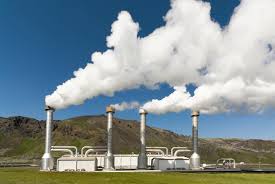Geothermal energy is the heat of the earth, herself. It manifests in different forms in different places. We all know the most common ways this energy shows itself, in the form of eathquakes, volcanoes, hot springs, and geysers. This is the energy that is tapped into in order to create electricity. More active regions of the world, especially around the edges of tectonic plates, are obvious choices for using geothermal energy. Some sources say that only these regions are capable of tapping into this energy, while other sources say that it can be tapped into anywhere on the planet. So let's discuss.
The basic laws of geothermal energy are that the closer you are to the source of the energy, the more energy you can tap into and acquire. Seems obvious, right? Well, yes and no. For larger scale production, it does help to have access to more energy. That's why most production facilities are located in or near geologically active regions. These facilities generally drill down to a depth of anywhere between 3 and 10 meters for greater access. For smaller scale, single home use, that depth is not necessary. At a depth of only 10 feet, or just over 3 meters, the ground temperature stays around 50-60 degrees F. The best part about geothermal energy is that it is constant and has tremendous efficiency. If you remember from my previous posts, the efficiency of solar and wind are both right around 22%, and hydro runs at 90%. For reference, coal/fossil fuel energy averages around 60%. Geothermal outperforms them all, running an average efficiency rating of 400%. Yes, you read that right - 400%. That means that for every unit of energy that is used, it produces 3-4.5 units of energy. Pretty awesome, huh? It can, however, be costly for the initial build, and there are some environmental concerns associated with using geothermal energy. For a decent list of pros and cons of using geothermal energy, this is a great resource.
There are three main types of systems to harness geothermal energy: dry steam, flash, and binary. A dry steam system pumps steam from fissures directly to a turbine, creating energy. Flash steam is a system where heated water from deep inside the earth is pumped into a container where it is cooled quickly to produce steam to drive a turbine. A binary system uses a secondary fluid that steams at a lower temperature than water. The heated water is pumped into a container that then heats the secondary liquid. That liquid is then turned to steam and sent to the turbine.
Now from what I can tell, this is a bit different from other types of alternative energy. First off, there just isn't a big variety of options. Basically, you either contact a qualified contractor that installs the entire system, which can be incredibly costly, or you purchase a heat pump and supplies, or even a kit, rent a backhoe (or some other way to dig), and lay the system yourself. I do believe that it can be done diy, as many people out there have done it. However, it does seem to go quite a bit easier if you have some basic knowledge of plumbing and possibly HVAC systems. This is a set-up that if not done correctly, it can cause serious headaches down the road.
Geothermal energy definitely has a lot of things that need to be seriously considered. High initial costs (although those are coming down), and not a simple diy project, but the potential is quite astounding. I don't know that this is a resource that I would personally tap into for the simple issue of initial cost. But if you do have a bit more to invest up front and are willing, it can be a great resource.




No comments:
Post a Comment